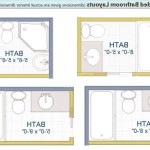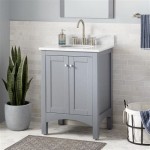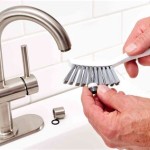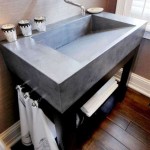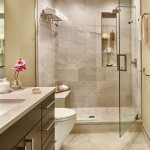Rear Drain Bathroom Sink: A Comprehensive Overview
Bathroom sinks are a crucial element of any bathroom design, offering both functionality and aesthetic appeal. While the overall design and material choices of sinks are widely considered, the drain placement is a subtle yet significant factor that can influence both the utility and style of the fixture. Among the drain configurations available, the rear drain bathroom sink offers distinct advantages that warrant careful consideration during bathroom renovations or new construction projects. This article provides a comprehensive overview of rear drain bathroom sinks, exploring their features, benefits, potential drawbacks, and key considerations for selection and installation.
A rear drain bathroom sink is defined by the positioning of its drain opening towards the back of the basin, rather than the more common central or front-positioned drain. This seemingly minor shift has a considerable effect on the overall functionality of the sink. The primary objective of this design is to maximize usable space within the sink basin. By placing the drain further back, a larger, less obstructed area is available for washing hands, rinsing items, or other common bathroom activities. This design modification can improve the user experience, particularly in smaller bathrooms where every inch of space counts.
Rear drain sinks are available in a wide range of materials, styles, and mounting options, mirroring the diversity seen in traditional center-drained sinks. From classic porcelain to modern glass and stone, the material selection is dependent on the desired aesthetic and budget. Similarly, they can be found as vessel sinks, undermount sinks, or wall-mounted sinks, providing flexibility in accommodating varying bathroom layouts and design preferences. The variety available ensures that a rear drain sink can be seamlessly integrated into nearly any bathroom design scheme.
Enhanced Usability and Space Optimization
One of the most significant advantages of a rear drain bathroom sink is its ability to maximize usable space within the basin. By relocating the drain to the rear, the central area of the sink remains clear and unobstructed. This is particularly beneficial for individuals who frequently use the sink for tasks involving larger items, such as washing delicate clothing or rinsing paintbrushes. The increased usable space also makes it easier to maneuver within the sink, reducing the risk of bumping into the drain or other obstructions. This design element contributes to a more efficient and comfortable user experience.
In smaller bathrooms, the space-saving benefits of a rear drain sink are even more pronounced. The streamlined design can make the bathroom feel less cramped and more functional. The extra room in the basin can also be helpful for individuals with mobility issues, allowing them to use the sink more comfortably and safely. The strategic placement of the drain allows for a more ergonomic design, catering to a wider range of users and needs.
Beyond the practical benefits, the increased usable space also contributes to a more aesthetically pleasing design. The clean, uncluttered look of the sink basin can enhance the overall visual appeal of the bathroom. By minimizing visual distractions, the rear drain sink allows the other design elements in the bathroom, such as the countertop, faucet, and tiling, to take center stage. This can create a more cohesive and harmonious overall aesthetic.
Improved Hygiene and Cleaning
The design of rear drain bathroom sinks also contributes to improved hygiene and ease of cleaning. With the drain positioned towards the back, there is less likelihood of water and debris accumulating around the drain opening. This reduces the chances of bacterial growth and the formation of unsightly stains. The smooth, unobstructed surface of the basin is also easier to wipe down and keep clean, further promoting a hygienic environment.
Furthermore, the rear drain design can help to minimize splashing. The position of the drain encourages water to flow directly towards the back of the sink, rather than splashing upwards or outwards. This can help to keep the surrounding countertop and floor dry, reducing the risk of water damage and the need for frequent cleaning. The reduced splashing also contributes to a more pleasant and comfortable user experience.
Cleaning a rear drain sink is similar to cleaning a traditional sink, but the absence of the drain in the center of the basin can make the process even easier. The unobstructed surface allows for a more thorough and efficient cleaning. Furthermore, the rear drain design often incorporates a removable strainer or stopper that can be easily cleaned to prevent clogs and maintain optimal drainage. Regular cleaning and maintenance will ensure that the sink remains hygienic and functional for years to come.
Considerations for Installation and Compatibility
While rear drain bathroom sinks offer numerous advantages, there are several considerations that should be addressed during the installation process. One of the most important factors is the existing plumbing configuration. Depending on the location of the drainpipe, modifications may be necessary to accommodate the rear drain. This could involve rerouting the drainpipe or using extension pieces to connect the sink drain to the existing plumbing. It is often recommended to consult with a qualified plumber to assess the situation and ensure that the installation is done correctly.
Another consideration is the type of faucet that will be used with the sink. The faucet should be positioned in a way that complements the rear drain design. For example, a wall-mounted faucet or a single-hole faucet positioned towards the back of the sink can create a streamlined and aesthetically pleasing look. It is important to choose a faucet that is both functional and visually compatible with the sink's design. Measuring the reach and height of the faucet is crucial to ensure that the water stream will reach the desired location within the basin.
The countertop material and style should also be taken into account when selecting a rear drain sink. The sink and countertop should complement each other in terms of both aesthetics and functionality. For example, a sleek, modern countertop made of quartz or granite would pair well with a contemporary rear drain sink made of porcelain or glass. The dimensions of the sink and countertop should also be carefully considered to ensure a seamless and visually appealing installation. The overhang of the countertop should be adequate to prevent water from dripping onto the cabinet below.
Additionally, the overall bathroom design should be considered before opting for a rear drain sink. The sink should integrate seamlessly into the existing layout and style of the bathroom. For example, if the bathroom has a minimalist design, a simple, understated rear drain sink may be the best choice. Conversely, if the bathroom has a more traditional design, a more ornate sink with a classical faucet may be more appropriate. The goal is to create a cohesive and harmonious overall design that reflects the homeowner's personal style and preferences.
The material of the sink itself is a crucial element to consider. While porcelain remains a reliable and classic choice, various other materials offer distinct advantages. Stainless steel provides durability and a modern aesthetic, while glass sinks offer a unique visual appeal and the ability to customize color and style. Stone sinks, such as granite or marble, impart a luxurious feel but require more diligent maintenance. The choice of material influences not only the sink's appearance but also its longevity, ease of cleaning, and resistance to stains and scratches. A careful assessment of these factors is essential before making a final decision.
Finally, budget constraints should be factored into the decision-making process. Rear drain bathroom sinks are available in a wide range of price points, from affordable models to high-end designer options. It is important to set a budget beforehand and to stick to it as much as possible. While it may be tempting to splurge on a more expensive sink, it is important to remember that there are many other factors to consider, such as the cost of installation, the type of faucet that will be used, and the overall cost of the bathroom renovation. By carefully considering all of these factors, homeowners can choose a rear drain bathroom sink that meets their needs and fits their budget.

Bathroom Archives Page 27 Of 33 Baths By Design

American Standard 0621001 020 Studio 22 Vessel Porcelain Build Com

Oval Porcelain 22 White Top Mount Bath Sink W Overflow Drain

Isabella Collection 28 Rectangular Wall Mount Basin With Integrated R Whitehaus

Custom Concrete Sinks Contemporary Bathroom Lavatory Design Trough Sink

Whkn1129 By Whitehaus Isabella Collection 23 Rectangular Wall Mount Bathroom Basin With An Integrated Oval Bowl Overflow Single Faucet Hole And Rear Center Drain Studio41

Whitehaus Whu71006 21 Inch Rectangular Undermount Basin With Overflow And Rear Center Drain

Whitehaus Whu71006 21 Inch Rectangular Undermount Basin With Overflow And Rear Center Drain

American Standard Boxe White Vitreous China Drop In Rectangular Bathroom Sink With Overflow Drain 24 56 X 18 88 0504000 020 Rona
